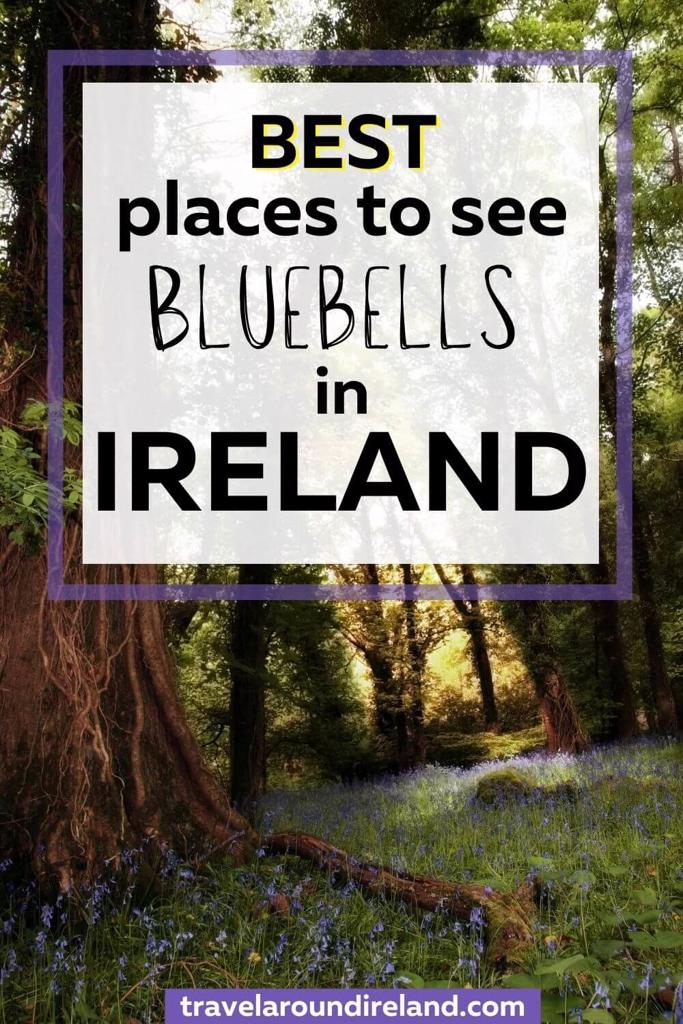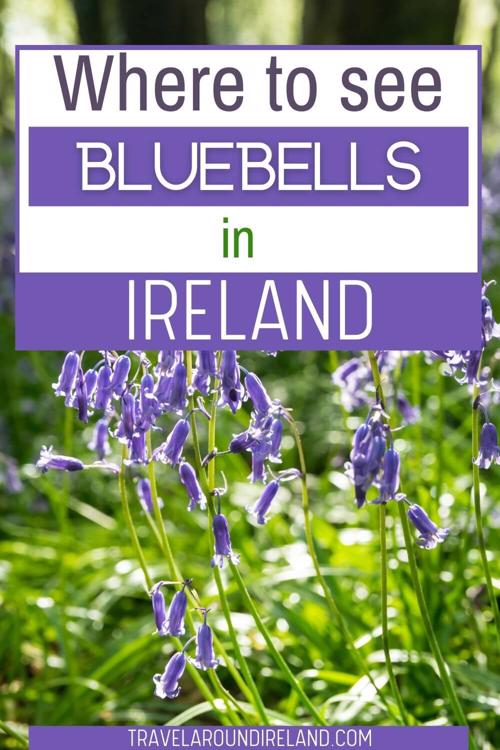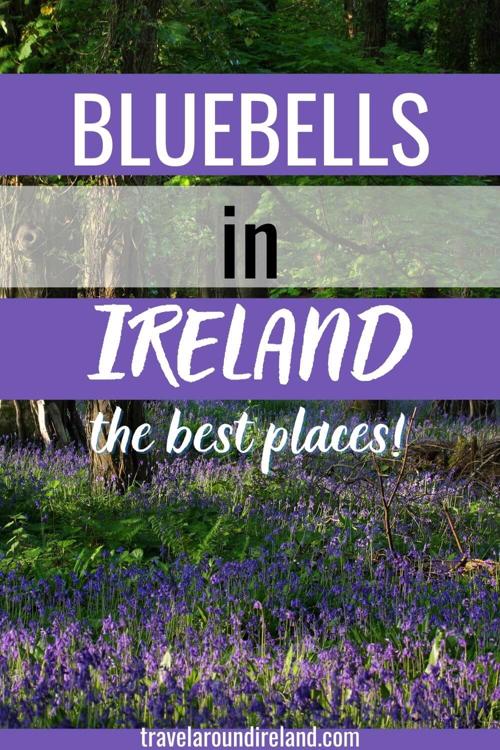Going to the Emerald Isle and love bluebells? Wondering where to find the best bluebells Ireland has to offer? Then check out this list of over 50 places to see these beautiful flowers across the country during Spring.
There is nothing that shouts “Springtime” more than a beautiful carpet of bluebells. Those delicate purple flowers, bobbing their heads in a gentle breeze. And if you are in Ireland there are lots of places to go to see them.
Bluebells are perennial flowers that can be found in woodland areas and are native to the British Isles and Ireland. Bluebells in the woods are a sign that Spring is in full swing and bluebell woods are often popular with visitors during the peak of the season between mid-April and late May.
If you are based in Ireland, or visiting the Emerald Isle, and are wondering “where can I see bluebells near me”, then this post will help you discover lots of places to go hunting for these beautiful purple flowers across Ireland.
Note: We advise you call ahead of your visit to ensure the areas are open to the public, particularly in places such as castle grounds and privately owned property.
- Where to see bluebells in Ireland (Republic)
- Bluebells in Leinster
- Tintern Abbey, Wexford
- Altamont Gardens, Carlow
- Inistioge to Thomastown Woods, Kilkenny
- Charleville Castle Estate, Offaly
- Killinthomas Woods, Rathangan, Kildare
- Knockbarron EcoWalk, Offaly
- Coolcarrigan House & Gardens, Kildare
- Glendalough, Wicklow
- Powerscourt Estate, Wicklow
- Vale of Clara, Wicklow
- Capponellan Wood, Laois
- Knockatrina Wood, Laois
- Jenkinstown Wood and Walled Garden, Kilkenny
- Huguenot Cemetery, Dublin
- Mullaghreelan Woods, Kildare
- Clogrennan Wood, Carlow
- Moore Abbey, Kildare
- Bluebells in Connaught
- Belleek Woods, Mayo
- Portumna Forest Park, Galway
- Coole Park, Galway
- Westport House, Mayo
- Hazelwood Forest, Sligo
- Mote Park, Roscommon
- Rinville Park, Galway
- Dromore Wood Nature Reserve, Clare
- Woodville Walled Garden, Galway
- Rinn Duin/Rindoon Wood, Roscommon
- Derreen Woods, Roscommon
- Lough Key Forest and Activity Park, Roscommon
- Lissadell Woods, Sligo
- Raheens Wood, Mayo
- Bluebells in Munster
- Bluebells in Ulster (Republic of Ireland)
- Bluebells in Leinster
- Where to see bluebells in Northern Ireland
- Downhill Demesne, Derry
- Castle Caldwell Forest, Fermanagh
- Derrymore House, Down
- Murlough National Nature Reserve, Down
- Narrow Water Forest, Down
- Castle Coole, Fermanagh
- Castlewellan Forest Park, Down
- Castle Ward, Down
- Mount Stewart, Down
- Cregagh Glen and Lisnabreeny, Down
- Minnowburn, Down
- Nugent’s Wood, Down
- Kilbroney Park, Down
- Springhill National Trust, Derry
- Ballyrobert Gardens & Nursery, Antrim
- Rowallane Gardens, Down
- Facts about bluebells
- Final thoughts on bluebells in Ireland
- FAQ about bluebells
Where to see bluebells in Ireland (Republic)
If you are in the Republic of Ireland and have been wondering where you can see Irish bluebells, then this section is dedicated to the 26 counties of the Republic of Ireland.
Bluebells in Leinster
Tintern Abbey, Wexford
Address: Saltmills, New Ross, Co. Wexford
Tintern Abbey is a Cistercian Abbey located on the Hook peninsula in County Wexford. The woodland surrounding the abbey comes alive in Spring with some of the best carpets of bluebells Ireland has to offer. Take time to visit the Abbey and its other gardens too.
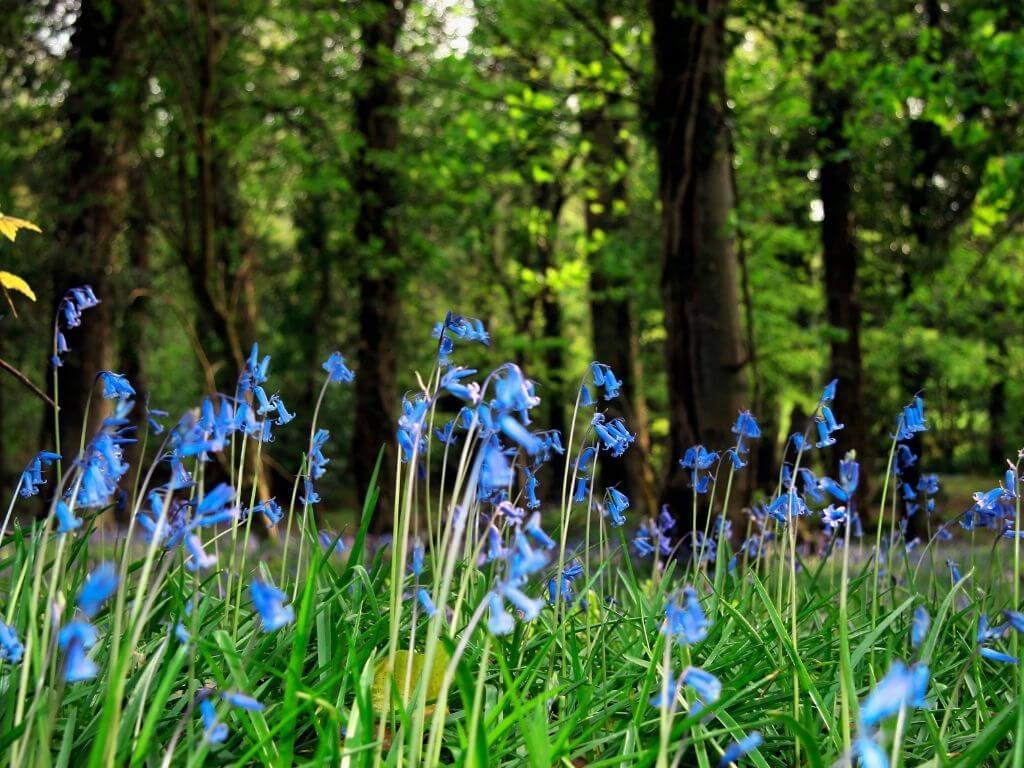
Altamont Gardens, Carlow
Address: Altamont, Co. Carlow, R93 N882
Altamont House is a historic house in County Carlow best known for its ornamental gardens. The estate covers 16 hectares in total and includes an arboretum, bog garden, and ice garden. At different times of the year, the garden spring to life with flowers of all kinds including snowdrops in early spring and bluebells in late spring. You’ll find the latter along woodland trails and woodland banks during the bluebell season in Ireland.
Inistioge to Thomastown Woods, Kilkenny
Address: Start from either Thomastown or Inistioge, Co. Kilkenny
There is a woodland trail between Thomastown and Inistioge in County Kilkenny that covers almost 11kms and along this route you can find beautiful carpets of native Irish bluebells during April and May. This is part of the Nore Valley Walk and the full trail will take between 2-3 hours. Note that dogs are not allowed.
Charleville Castle Estate, Offaly
Address: Charleville Demesne, Tullamore, Co. Offaly
Charleville Castle is a Gothic-style castle dating from the early 19th-century. Situated in Ireland’s most ancient primordial oak wood, the landscape is perfect for bluebells that adorn the woodland floor during late spring. As well as discovering the bluebells along the trails in the woods, visitors can take guided tours of the castle and discover more about its history and architecture.
Killinthomas Woods, Rathangan, Kildare
Address: 2 Woodlands, Killyguire, Rathangan, Co. Kildare
If you are in County Kildare, then head to Killinthomas Woods near Rathangan to see bluebells in spring. This wood contains 10km of signposted walks suitable for those of all abilities and is filled with beautiful bluebells in spring. The site is a 200-acre amenity area with a mixture of flora and fauna to enjoy. Walks start and finish at the car park.
Knockbarron EcoWalk, Offaly
Address: Knockbarron Wood, Kinnitty, Co. Offaly
Nestled in the foothills of the Slieve Bloom mountains, close to the picturesque village of Kinnitty in County Offaly, you will find Knockbarron Woods. This old woodland is one of the most intact esker systems in Ireland (an esker system is a long narrow winding ridge of sand or gravel, deposited by a stream flowing under a glacier). Great to visit at any time of the year, the woods come alive with bluebells in spring, covering the wood floor under the beech, oak, ash, pine, and spruce trees. Knockbarron EcoWalk starts at the car park and is approximately 5km in length.
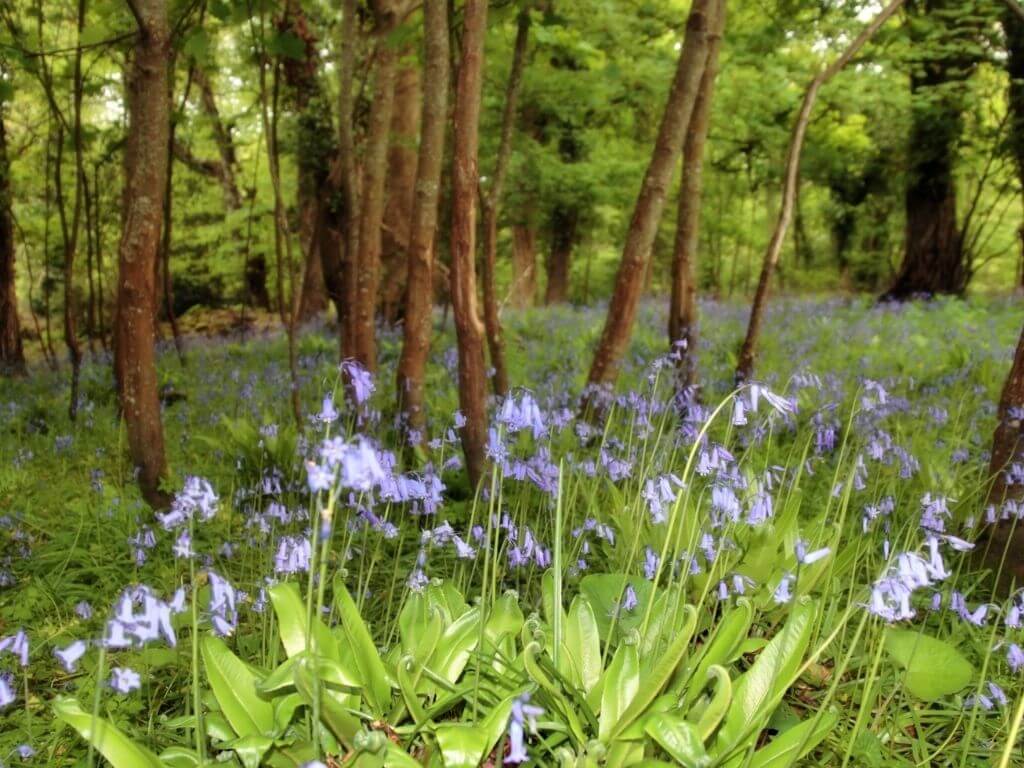
Coolcarrigan House & Gardens, Kildare
Address: Coill Dubh, Naas, Co. Kildare
A hidden oasis on the edge of Bog Allen, Coolcarrigan House and gardens comprises 15 acres of gardens and arboretums to explore. In late spring, the main avenue comes alive with bluebells that follow earlier spring bulbs such as snowdrops and daffodils. The gardens are worth returning to during the year to see other plants, shrubs, and trees.
Glendalough, Wicklow
Address: Glendalough, Co. Wicklow
Glendalough, the site of the 6th-century monastic site and two beautiful lakes is surrounded by natural woods. Situated in one of Ireland’s great National Parks, the oakwood floor comes to life in spring with carpets of purple bluebells. There are nine walking trails around Glendalough, but the Derrybawn Woodland Trail (orange route) is one of the best for spotting bluebells. It is 8km long, climbs alongside the Poulanass Waterfall, one of the best waterfalls in Ireland, and will take approximately 2 hours.
Powerscourt Estate, Wicklow
Address: Powerscourt Demesne, Enniskerry, Co. Wicklow
Just 35 minutes from Dublin you will find the Powerscourt Estate with its 47-acre gardens and waterfall. Near the Pepperpot Tower, in Tower Valley, you’ll find the lawns covered with delicate bluebells under the century-old trees.
Vale of Clara, Wicklow
Address: near the village of Clara, Co. Wicklow
The Vale of Clara is a large national nature reserve covering an area of 545 acres. Possibly one of the largest hardwood woods in Ireland, this is a great place for a springtime stroll to see bluebells. Nestled under the hazel, willow, birch, and holly trees, you will find carpets of Irish bluebells during the season. One of the best places to see them is where the Clara Loop meets the Avonmore Way.
Capponellan Wood, Laois
Address: Capponellan, Barnhill, Co. Laois
Capponellan Woods is an old estate wood on the grounds of the former Castledurrow Estate and contains beech, pine, spruce, oak, ash, birch, and hazel and were established to provide game cover. The Bluebell Walk is a trail leading you through the woods, just make sure to choose the right-hand trail in the fork a little way from the entrance. Read this post about other things to do in County Laois.
Knockatrina Wood, Laois
Address: Durrow, Co. Laois
In Knockatrina Woods near Durrow in County Laois, you will be able to see bluebells during spring. While this is a short 1-mile loop on easy terrain, you will be rewarded by carpets of bluebells in the woods, along with wild garlic.
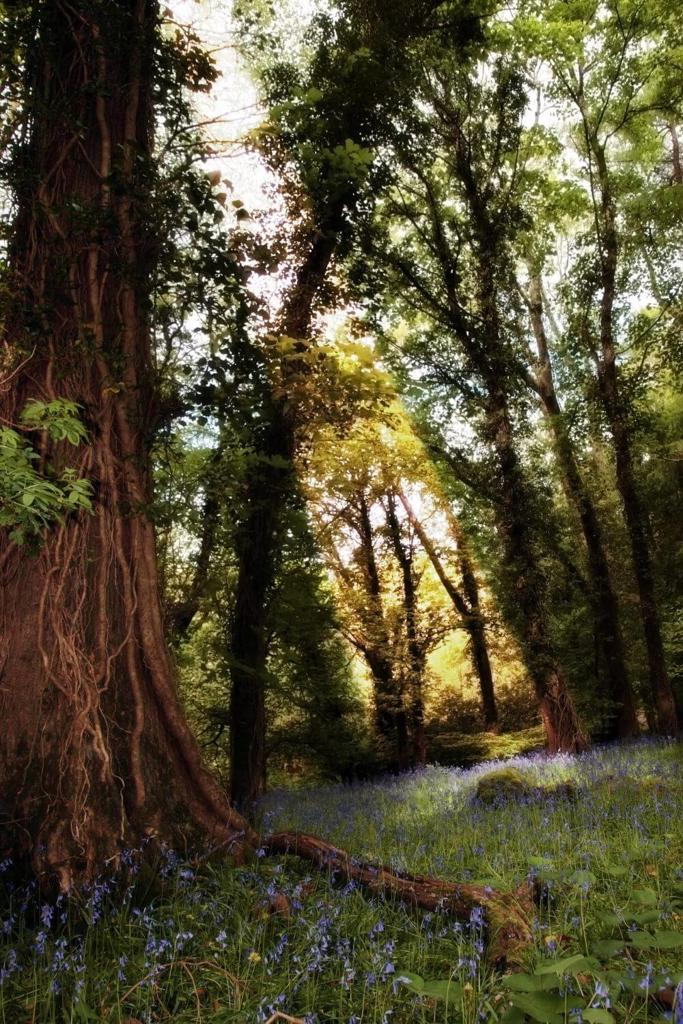
Jenkinstown Wood and Walled Garden, Kilkenny
Address: Jenkinstown, Co. Kilkenny
Formerly part of the Bryan Bellew Estate, Jenkinstown Woods are woods with beech trees that come alive in late spring with bluebells. There are two looped walks in the woods of 2.5 and 4kms, respectively. There is a walled lawn area next to the house and a deer enclosure near the car parks. With easy walking trails, toilets, and picnic areas, this is a great place to see bluebells in Ireland with kids.
Huguenot Cemetery, Dublin
Address: Merrion Row, Dublin 2
This cemetery, located just off Merrion Square is one of Dublin’s most colourful when the bluebells are in full bloom. You cannot enter but you can peer through gates just off Merrion Square.
Mullaghreelan Woods, Kildare
Address: R418, Mullaghreelan, Co. Kildare
This picturesque old woodland estate adjoins Kilkea Castle southeast of Athy, and it encircles a hilltop rath that overlooks Kilkea Castle. There are several trails for those of abilities of all kinds, but the Mullaghreelan Wood Loop is a 2.3km loop along which you can see amazing displays of bluebells in spring.
Clogrennan Wood, Carlow
Address: Raheendoran, Co. Carlow
Located not far from Carlow Town is Clogrenna Wood with its 4km sloping walk through the forest. The area is an old wood with oak, beech, larch, and spruce whose ground is covered in swathes of bluebells during spring. Visitors will be rewarded not only with the bluebells but also views of Carlow Town and the River Barrow.
Moore Abbey, Kildare
Address: Monasterevin, Co. Kildare
Moore Abbey is a monastic house on the site of a previously ruined 5th-century monastery. The house is surrounded by woods that offer a beautiful display of bluebells in spring. The wood has 3 looped walks that offer trails for those of all abilities and the Bluebell Way, a 2.5km trail that takes around 40 minutes is a nice walk through a Cypress-lined avenue along which you’ll find the bluebells.
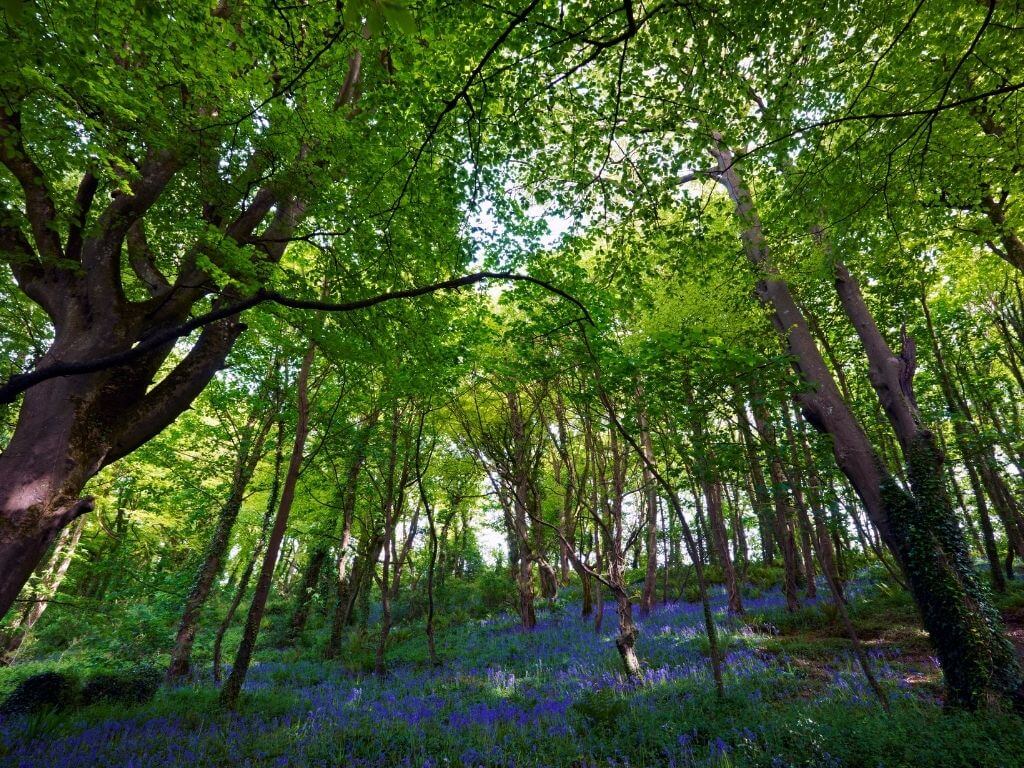
Bluebells in Connaught
If you are based in the west of Ireland and have been asking yourself where to see bluebells near me, then this is the section for you, with a list of places to find bluebells in Connaught.
Belleek Woods, Mayo
Address: Belleek Wood, Belleek, Ballina, Co. Mayo
Stretching for 6 miles, Belleek Woods in Ballina in County Mayo is one of the largest urban forests in Europe and is where you can enjoy bluebells in spring. There are family-friendly walks along the banks of the river. Families can also enjoy Belleek Woods Fairy Trail and you might even spot some of the fauna of the woods which includes red squirrels, pine martins, hares, foxes, and birds such as herons, ducks, and more.
Portumna Forest Park, Galway
Address: 6 St Joseph’s Rd, Portumna Demesne, Portumna, Co. Galway, H53 AH10
Covering almost 450 hectares, Portumna Forest Park is a great place to visit in Galway to find bluebells in spring. You can find the best fields of bluebells under the beech trees in an area known as the ‘Ladies Tea Garden’. At Portumna Forest Park you can also enjoy one of the 4 walking trails in the forest, cycling trails, and even an old abbey and castle.
Coole Park, Galway
Address: Coole Demesne, Co. Galway
Located 4km northwest of Gort is Coole Park Nature Reserve, covering nearly 400 hectares. Coole is an area where wetland meets woodland with seasonal lakes, underground rivers, and more. The woods contain oak, ash, hazel, yew, elm and beech. There are two trails through the nature reserve and it is along the ‘Seven Woods Trail’ where you will spot bluebells during spring
Westport House, Mayo
Address: Quay Rd, Westport Demesne, Westport, Co. Mayo, F28 K6K6
Westport House is a Georgian-era estate and is one of the best things to do in County Mayo. As well as the beautiful Manor House, there are over 400 acres of grounds with some lovely woodland walks. And it is along the 3.5km looped walks through the woodland that you’ll find carpets of bluebells in spring.
Hazelwood Forest, Sligo
Address: Kiltycahill, Co. Sligo
Part of the Wynne Estate, Hazelwood is a beautiful forest near the house of the same name. The forest has some looped walks, the main one being 3km long with shorter alternatives also available. The loop brings you to the lakeshore where you can enjoy views across Lough Gill, one of the best places to visit in County Sligo. It is under the trees along this woodland trail where you can see the bluebells in spring.
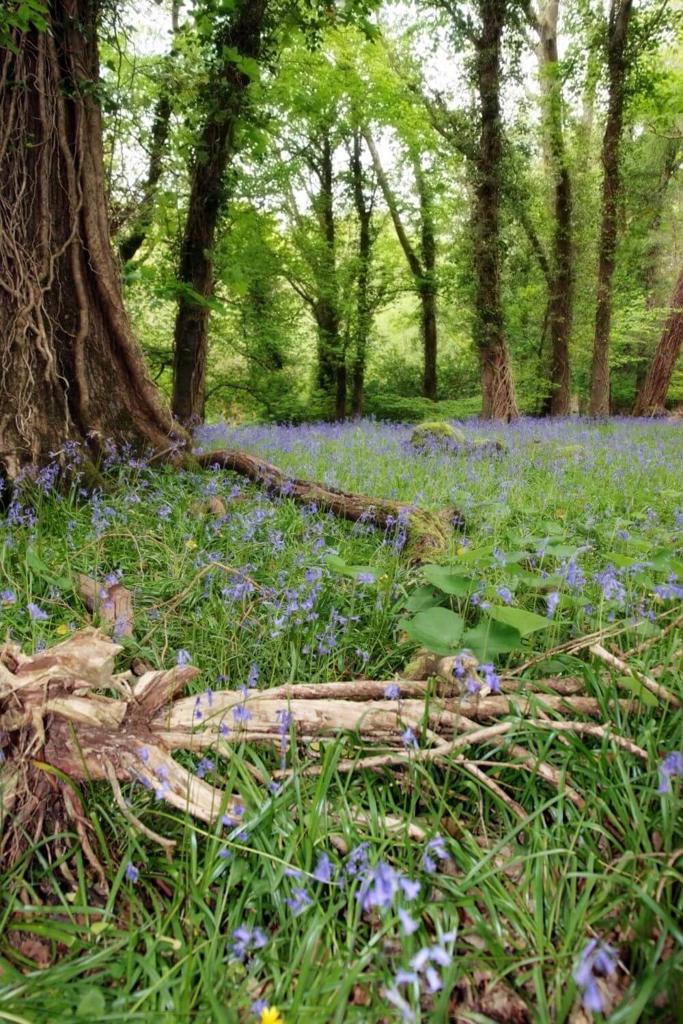
Mote Park, Roscommon
Address: Ballymurray, Elphin, Co. Roscommon
In the heart of County Roscommon is Mote Park, formerly the seat of the Crofton Family. This outdoor recreational park is a gateway to
Heritage, history, flora, fauna and the environment.
Known for its forests which cover 650 hectares, you will find two way-marked trails in the forests, one of which is the Bluebell Loop. This easy 1.5km walk brings visitors through a plantation of Norwegian Spruce and replanted spruce, Scot’s pine, and oak. It is here, in spring, where you can enjoy bluebells.
Rinville Park, Galway
Address: Marshallspark, Co. Galway
One of the best places to visit in County Galway for nature is Rinville Park close to Oranmore. Created around an ancient castle, a stately home, and a demesne estate, it is around the castle where you can find bluebells from mid-April to late May. Enjoy a walk along the easy 2.3km looped trail and watch out for the purple flowers.
Dromore Wood Nature Reserve, Clare
Address: Ruan, Co. Clare
8km north of Ennis on the main Ennis-Galway (N18) road, in the southeastern extremity of the Burren National Park, you will find Dromore Wood Nature Reserve. An area of approximately 400 hectares, along both the Rabbit Island and Castle trails visitors can see bluebells during spring. Trails are between 1.5km and 7km long, and both the mid-Clare Way and the Loop Walk intermingle with the reserve trails.
Woodville Walled Garden, Galway
Address: Woodville House, Woodville, Kilchreest, Co. Galway, H91 VEY2
Woodville House is home to a restored walled kitchen garden with a museum outlining the connections with Lady Augusta Gregory. It is also where visitors can see bluebells during the bluebell season. During the year, it is also worth visiting for its snowdrops in early spring, tulip display, Easter events, and more.
Rinn Duin/Rindoon Wood, Roscommon
Address: Warren, Co. Roscommon
A deserted village founded in the 13th-century, Rindoon incorporates the remains of a castle, medieval walls, a mill, and church. Rindoon also sits out on a peninsula into the west side of Lough Ree. Accessible from the car park, the woods at Rindoon, St. John’s Wood, are awash with purple bluebells in spring.
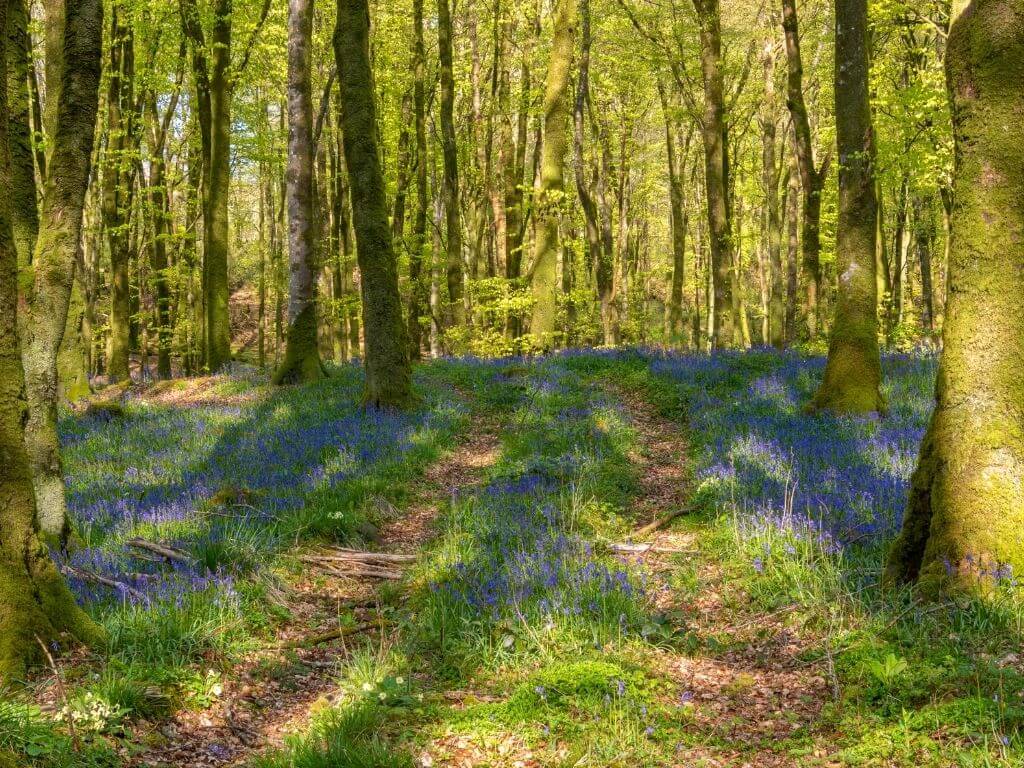
Derreen Woods, Roscommon
Address: R285, Turlagh, Co. Roscommon
Located near Knockvicar, Derreen Wood is also known as Bluebell Wood and during spring it is easy to see why. There are no marked trails through the woods, but this simply adds to the natural feel of the woods. Those visiting with kids should look out for the Derreenies, little fairy houses hidden around Derreen Garden close to the woods.
Lough Key Forest and Activity Park, Roscommon
Address: Boyle, Co. Roscommon, F52 PY66
Located on the grounds of the Rockingham Estate, the Park at Lough Key Forest and Activity Park is a great place in County Roscommon to see bluebells in spring. They are springtime wildflowers that can be found throughout the woodland areas of the park. You will also find them around the Fairy Ring.
Lissadell Woods, Sligo
Address: Lissadell Estate, Lissadell, Co. Sligo
The woodlands around the Lissadell Estate are another great place in the west of Ireland to see bluebells in spring. There is a little-known walk through the woods around the estate, that starts at the car park at the main beach, and which leads you to the Birdwatch Ireland hide near the edge of the Goose Field at Ballygilgan Nature Reserve. It is in the woodland along this walk where you can see Irish bluebells in spring.
Raheens Wood, Mayo
Address: Raheens, Co. Mayo
Just 4km from Castlebar, on the Newport Road, you can find Raheens Wood, a woodland of around 33 hectares dating from the mid-19th century. This great example of a native woodland inhabitant has tree species including hazel and birch, with occasional oak, ash, willow, rowan, and alder. The wood is carpeted with bluebells during May, making it a great place in Ireland to see bluebells.
Bluebells in Munster
If you are based, or are visiting, the south of the Emerald Isle during April and May and are wondering where to go to find bluebells, then this section is the one for you.
Killarney National Park, Kerry
Address: Killarney, Co Kerry, V93 HE3C
Killarney National Park is one of the best National Parks to visit in Ireland and during late April and May, it is one of the best places in Ireland for bluebells. Although they can be found throughout the National Park, two of the best places to visit to see these springtime flowers are around Ross Castle and along the road just past the Lake Hotel on the Muckross Road, as they are easily accessible.
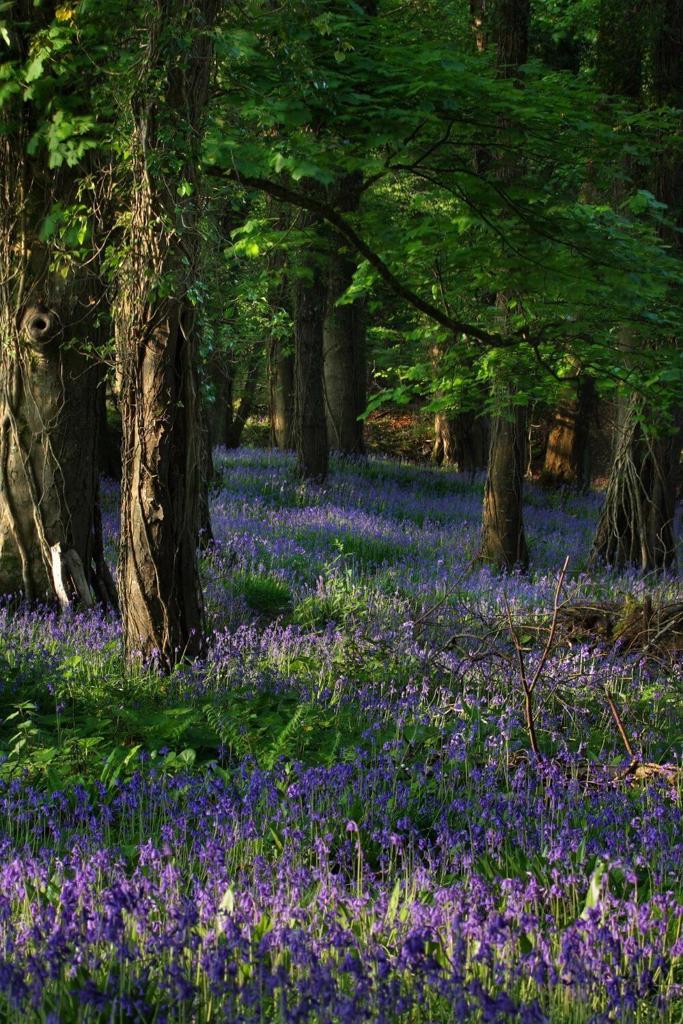
Currabinny Woods, Cork
Address: Crosshaven, Co. Cork
Located on a prominent hill overlooking Cork Harbour, Currabinny Woods is a great place to go hunting for bluebells if you are based in County Cork. Currabinny Woods is a compact woodland covering just 35 hectares and there are two trails you can hike or bike along. The woodland along these trails is rich with bluebells during spring.
Curraghmore Estate, Waterford
Address: Curraghmore, Portlaw, Co. Waterford, X91 X598
One of the best historical houses to visit in County Waterford is Curraghmore House near Portlaw. And the best time to visit is during spring when the woodland walks around the estate are carpeted with bluebells and wild garlic. See them on the floor underneath oak, beech, maple, cedars, and spruce trees. While the estate can be visited at any time of the year, spring is one of the best.
Golden Grove Forest, Tipperary
Address: Golden Grove, Roscrea, Co. Tipperary
Formerly part of the Lloyd-Paisley-Hutchenson-Vaughan Estate, Golden Grove is an old woodland site filled with ash, beech, pine, and spruce trees under which visitors can enjoy seeing carpets of bluebells during spring. Access to the woods is at the rear of Dromakeenan School, on the Birr Road, about a mile out of Roscrea Town.
Ballyannan Wood, Cork
Address: Ballynacorra, Ballinacurra, Co. Cork
A beautiful mature, mixed woodland located in the south of the town in Midleton, County Cork, is Ballyanna Wood. Spanning just 25 hectares, it is a great place to visit in mid-April to early May to see bluebells. There are other features throughout the forest to enjoy while walking and hunting for carpets of bluebells.
Doneraile Court and Wildlife Park, Cork
Address: Doneraile Demesne, Co. Cork, P51 XR66
11km northeast of Mallow you will find Doneraile Court and Wildlife Park. And if you want to see bluebells in County Cork during April and May, this is a great place to visit. There are lots of woodland walks with restored water features along the way. You might be lucky to spot deer herds, and much of the woodland that runs parallel to the pathways through the park is carpeted with bluebells during spring. The pathways are mostly flat, making them ideal for those with mobility issues or young kids.
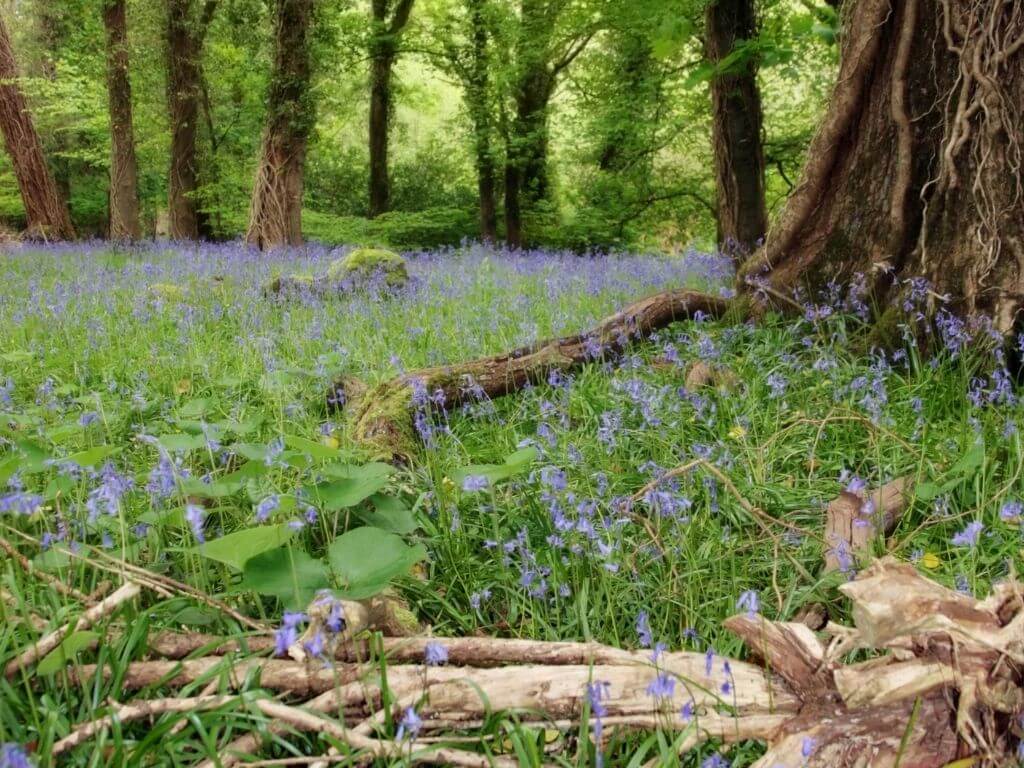
Courtmacsherry Woods, Cork
Address: Courtmacsherry, Bandon, Co. Cork
Just past Courtmacsherry Hotel and over the stiles is a path that will lead you to the Bluebell Walk, a well-known trail for nature lovers in the area. There you can enjoy lots of purple bluebells during spring.
Bluebells in Ulster (Republic of Ireland)
This section covers the counties of the Republic of Ireland that is part of the province of Ulster and lists where you can find bluebells within them.
Deerpark, Cavan
Address: Deerpark, Co. Cavan
Deerpark Forest is a forest with mixed woodland covering 160 hectares and is an ideal place in Cavan to find bluebells during spring. There are three forest trails throughout which you can see these distinctive purple flowers.
Drumboe Woods, Donegal
Address: Drumboe Ave, Stranorlar, Co. Donegal
Drumboe Woods is a great place in County Donegal to see bluebells in spring. Standing on the former Hayes Estate, there is a car park from which you can take one of three short, way-marked trails to discover carpets of purple during the bluebell season.
Oakfield Park, Donegal
Address: Oakfield Demense, Raphoe, Co. Donegal, F93 XY1R
Oakfield Demesne is a privately-owned estate and railway that is open to the public. In the mature woodland on the estate, visitors can enjoy woodland walks that are awash with purple bluebells during spring. There are also lots more to discover and enjoy at Oakfield Park.
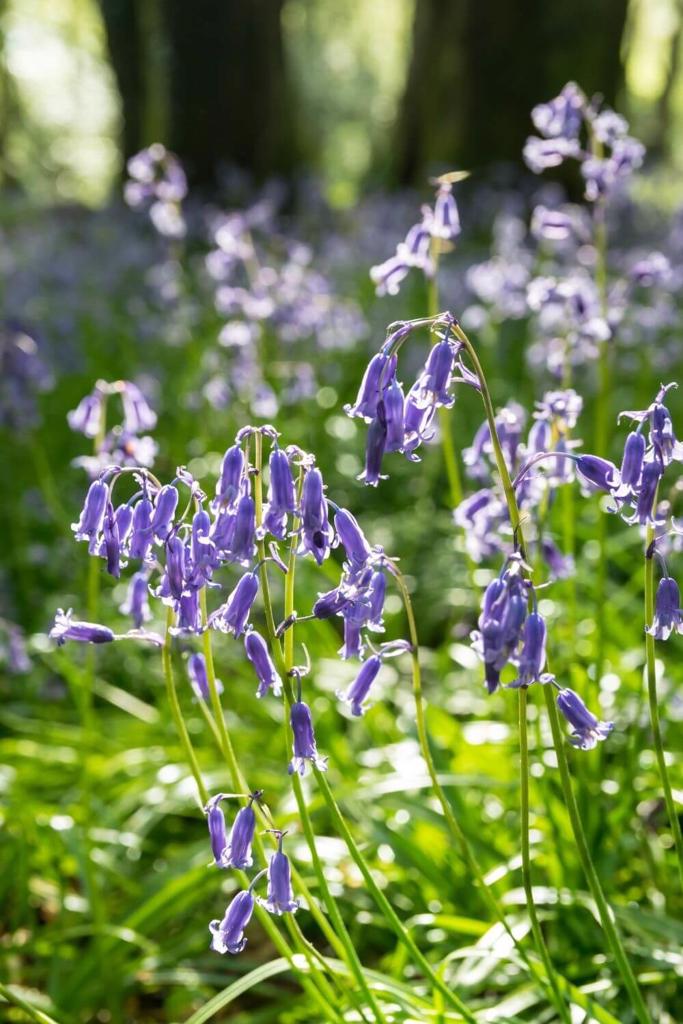
Where to see bluebells in Northern Ireland
If you are looking to see the best bluebells Northern Ireland has to offer you, then you will find a location in this section in Northern Ireland to enjoy this springtime, purple flowers.
Downhill Demesne, Derry
Address: Mussenden Rd, Castlerock, Coleraine, Co. Derry, BT51 4RP (UK)
One of the most visited National Trust sites in Northern Ireland is Mussenden Temple and Downhill Demesne. As well as being one of the most popular places to visit in Northern Ireland, it is also one of the best places to discover bluebells. Its clifftop gardens are a wonderful place to visit, and you can uncover bluebells in spring around the Bishop’s Gate garden in particular.
Castle Caldwell Forest, Fermanagh
Address: A47, Enniskillen, Co. Fermanagh, BT93 2AH (UK)
Part of the Marble Arch Caves Global Geopark, Castle Caldwell Forest is a 200 hectare, mixed broad-leaf, and coniferous forest and is one of the top places for bluebells in Northern Ireland. The geopark straddles the border between the Republic and Northern Ireland. There is a Circular Beech Wood Walk at Castle Caldwell that takes approximately 45 minutes through the woods and it is in these woods that you can find bluebells.
Derrymore House, Down
Address: Bessbrook, Newry, Co. Down BT35 7EF, (UK)
Derrymore House is an 18th-century thatched house owned and run by the National Trust in Northern Ireland. In the borders and woods around the house, you can enjoy bluebells in spring. However, the bluebells here have a surprise in store for visitors, with both purple and white bluebells to be seen (see Facts about bluebells below for more detail). It is believed that previous owners or gardeners of Derrymore collected the rare white bluebell, propagated them, and planted them around the house where they have naturally multiplied and where they thrive to this day alongside their natural counterparts.
Murlough National Nature Reserve, Down
Address: Keel Point, Dundrum, Newcastle, Co. Down, BT33 0NQ (UK)
Home to one of the best beaches in Ireland, Murlough National Nature Reserve has a wonderful woodland walk to enjoy. Along this walk, the bluebells come alive in spring in the woods under the trees, many of which were planted in the late 1800s. You will also see swathes of bluebells in the wildflower meadows on the reserve during spring.
Narrow Water Forest, Down
Address: Newry, Co. Down, BT34 2PR (UK)
There is a Bluebell Wood to visit near Warrenpoint in Northern Ireland called Narrow Water Forest. There is no public access so if you are visiting, be respectful. This is a mixed coniferous and broadleaf woodland where the forest floor is covered with bluebells during spring.
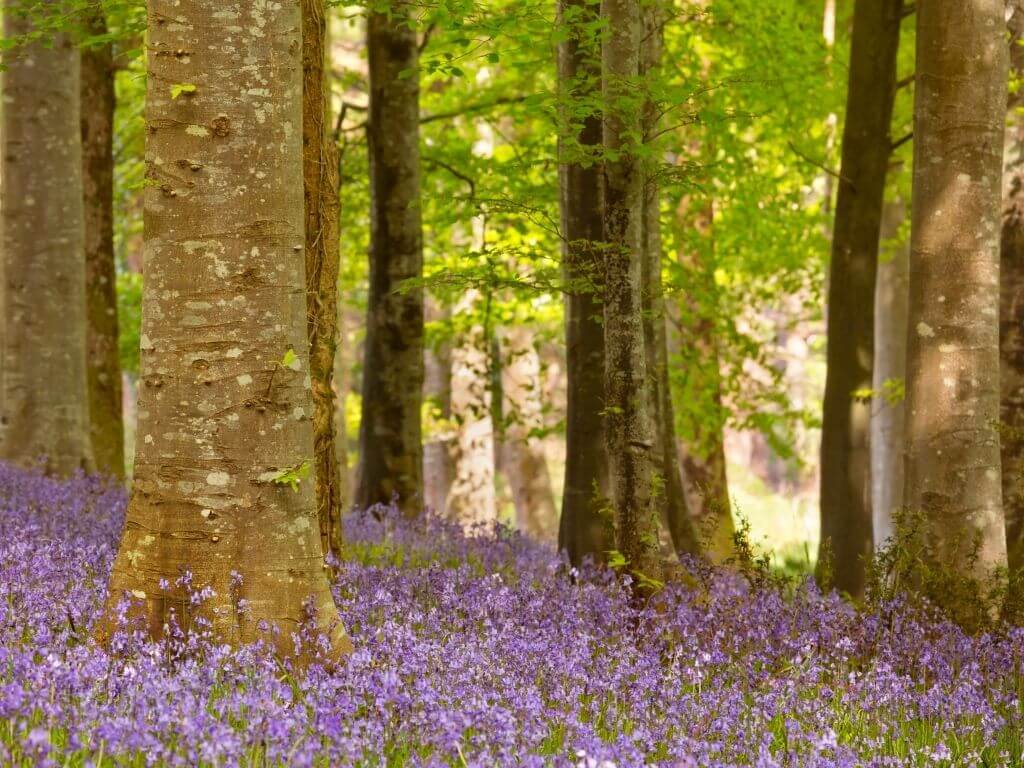
Castle Coole, Fermanagh
Address: Castle Coole, Enniskillen, Co. Fermanagh, BT74 6JY (UK)
Castle Coole is a late 18th-century Neo-classical mansion located in Enniskillen in County Fermanagh where you can see a carpet of purple bluebells in spring. Set in a 1200-acre wooded estate, there is plenty of opportunities to see bluebells, especially along the Beech Walk and in sheltered areas under the oaks along the main drive. Blooming between May and June the bluebells were planted over 100 years ago by the daughters of the 4th Earl Belmore.
Castlewellan Forest Park, Down
Address: Forest Park View, Castlewellan, Co. Down, BT31 9BU (UK)
Covering 450 hectares and located in the land lying north of the Mourne Mountains is Castlewellan Forest Park. There are lots of looped walks through the forest park but it is said that some of the best displays of bluebells in spring can be found on the trail that goes along the slopes of Slievenaslat, which will also give you panoramic views of the Mourne Mountains and surrounding landscape.
Castle Ward, Down
Address: Strangford, Downpatrick, Co. Down, BT30 7BA (UK)
Another great place to go spotting bluebells in spring is Castle Ward, located near the village of Strangford in County Down. This 18th-century National Trust property features 332 hectares of landscaped gardens, a fortified tower house, and more, and it has 5 miles of bluebell trails to explore in spring near the 18th-century Palladian Mansion.
Mount Stewart, Down
Address: Portaferry Rd, Newtownards, Co. Down, BT22 2AD (UK)
Mount Stewart in County Down is a neo-classical house, with gardens and demesne. It has lots of woodlands with trails that come alive with the distinct color of purple of bluebells during spring.
Cregagh Glen and Lisnabreeny, Down
Address: A55 Upper Knockbreda Rd, Belfast, Do. Down, BT6 9QL (UK)
Just east of Belfast you will find the National Trust property of Lisnabreen and Cregagh Glen Woods. There is a linear route that follows the glen and climbs a path to the hill fort to the summit of Castlereagh Hills. In spring, the woods that are found along the glen towards the waterfall are covered in bluebells.
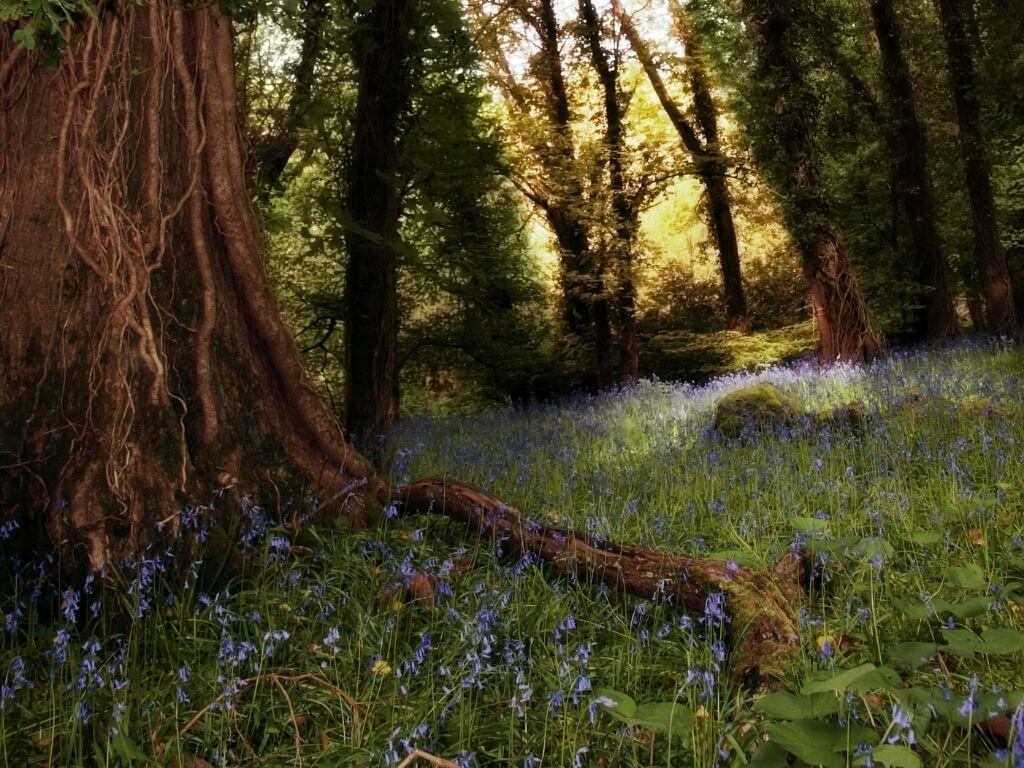
Minnowburn, Down
Address: Edenderry Rd, Belfast, Co. Down, BT8 8LE (UK)
Another National Trust property on the edge of Belfast to find bluebells in spring is Minnowburn, a 128-acre woodland and countryside site. At Minnowburn you will find tranquil meadows and woodlands stretching to the Lagan River. Along the Giant’s Ring path is where you will find the best of the bluebells during the season.
Nugent’s Wood, Down
Address: Portaferry, Newtownards, Co. Down, BT22 1PF (UK)
A wonderful mixed woodland area, Nugent’s Wood in County Down is another place to see the best bluebells Northern Ireland has to offer. It is a refuge for native red squirrels and visitors can enjoy spectacular views across the Strangford Narrows while hunting for bluebells during spring.
Kilbroney Park, Down
Address: Kilbroney Park, Rostrevor, Co. Down, BT34 3AA (UK)
Kilbroney Forest Park, formerly a country estate, features an arboretum and riverside walks and is a great place to see bluebells in Northern Ireland. It is said that it may have been the inspiration for Narnia by C.S. Lewis who visited the estate. Other writers who visited include Charles Dickens and Seamus Heaney.
Springhill National Trust, Derry
Address: 20 Springhill Rd, Moneymore, Magherafelt, Co. Derry, BT45 7NQ (UK)
Among the best places to see bluebells in Northern Ireland in late spring is Springhill, another National Trust property. A 17th-century plantation house has lawns and woodland areas that are blanketed with bluebells in the springtime. Enjoy the blankets of these purple flowers along the Beech Tree walk and enjoy the view from the old tower as well.
Ballyrobert Gardens & Nursery, Antrim
Address: 154 Ballyrobert Rd, Ballyclare, Co. Antrim, BT39 9RT (UK)
A great place to see bluebells in Northern Ireland is Ballyrobert Gardens and Nursery. The bluebells can be seen in the Glenlinchy Borders area during late spring and the other woodlands areas of Ballyrobert gardens. In early spring these same areas are alive with snowdrops, while the gardens are worth visiting at other times of the year for other plants, flowers, shrubs, and also autumnal foliage colours.
Rowallane Gardens, Down
Address: Crossgar Rd, Saintfield, Ballynahinch, Co. Down, BT24 7LH (UK)
Started in the 1860s by Reverend John Moore, Rowallane Gardens is a National Trust Property with a total of 50 acres to enjoy including walled gardens, wildflower meadows, tea rooms, and more. During late spring, visitors can view bluebells in the woodland area of the gardens. At Rowallane Gardens, there are plenty of garden areas to explore and you can enjoy a cuppa from the tearoom after.
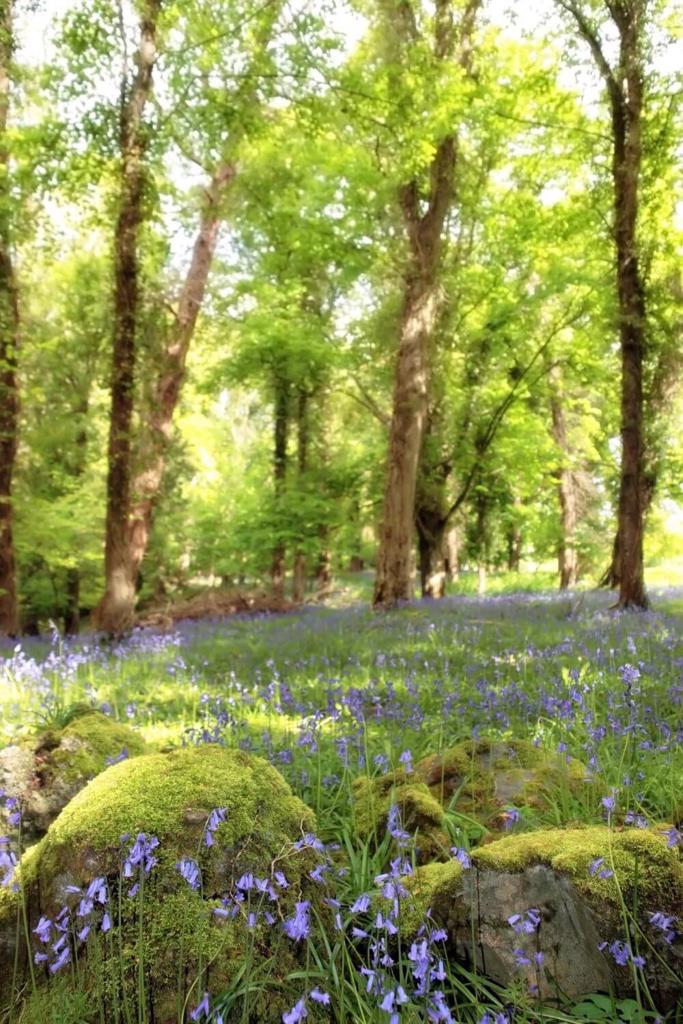
Facts about bluebells
It takes a bluebell 5 years to grow from seed to the purple flower we all know and love. You should also avoid trampling or walking on them as it takes them a long time to recover from footfall damage.
The bluebell is a sign of ancient woodland or forests.
Half the world’s bluebell population can be found in Ireland and the United Kingdom.
Bluebells are an early source of nectar for bees and butterflies, and should not be picked.
Bluebells are protected under the Wildlife and Countryside Act 1981 in the United Kingdom and digging them up could land you a hefty fine.
Bluebells have no pollinator competitor and hence grow in abundance in woodlands and forests.
Bluebell bulbs contain starch that was used in Elizabethan times to stiffen ruffs.
Gum from bluebell roots was once used as a glue in arrows and bookbinding.
The Spanish bluebell is a non-native bluebell that is easily hybridized with native bluebells, making them harder to distinguish.
Native bluebell flower stems droop while non-native bluebell flower stems are stiff and upright.
There is a rare, white bluebell (pictured below) that is as a result of a genetic mutation that results in white flowers instead of violet flowers. It is estimated that the proportion of blue to white bluebells is 10,000: 1, meaning you will only find one white bluebell for every ten thousand. If you are looking to see the best white bluebells Ireland has to offer, head to Derrymore House where they can be viewed in among the purple bluebells (see above).
Bluebells are also known as ‘fairy flowers’ and folklore says that picking a bluebell will result in you being led astray or trapped by fairies.
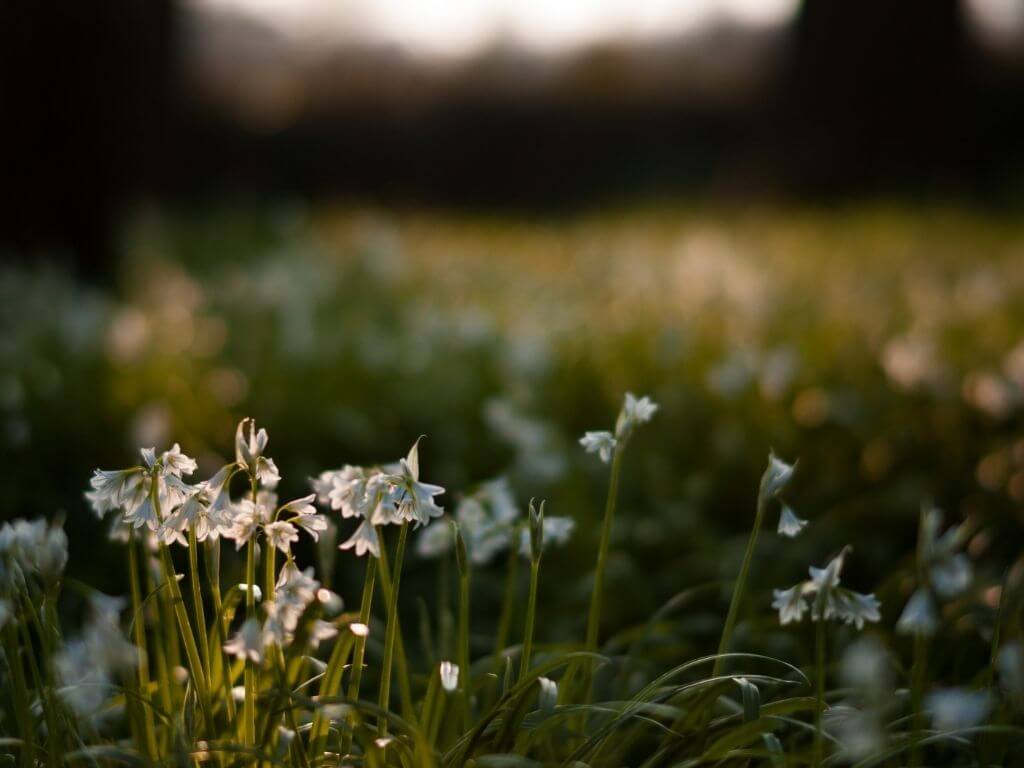
Final thoughts on bluebells in Ireland
While the above list of the places to see the best bluebells Ireland has to offer is extensive, it is by no means exhaustive. Many other forests and woodlands across the Emerald Isle may have bluebells in spring.
If you know of somewhere else to see bluebells in Ireland that you feel deserve to be added to the list, let us know and we’ll add it to the list!
FAQ about bluebells
Discover more things to do during Spring in Ireland:
- Where to Find Snowdrops in Ireland
- Where to See Daffodils in Ireland
- St Patrick’s Day in Ireland
- Visiting Ireland in March
- Visiting Ireland in April
- Visiting Ireland in May
